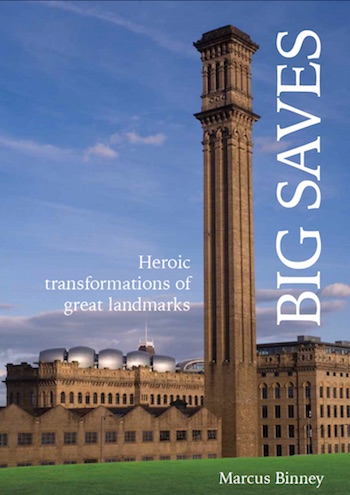Post
BOOK REVIEW | Big Saves: Heroic Transformations of Great Landmarks
26 Sep 2016
Big Saves: Heroic transformations of great landmarks by Marcus Binney.
Available from SAVE Britain's Heritage
Review by Janice Morphet
SAVE has played – and continues to play – a major role in changing the way the nation (and the rest of the world) thinks about places. It has not only saved many individual buildings from destruction, showing how they can be brought back into life, but has also changed the way we think about the role of historic places, and what they mean for the present.
Just as the Government is investigating the value of culture to the economy, SAVE has always worked with financial analyses, demonstrating economic benefits to all sectors. Marcus Binney, the founder of SAVE and author of Big Saves, illustrates the organisation’s specific work over the past forty years. Saving and reusing the nation’s heritage has not been reliant on the state, as in other European countries, but part of the fabric of development, with planners, local politicians and the private sector frequently following local voluntary society and community effort. This story started in London.
SAVE was founded in 1975 during European Architectural Heritage Year. As Marcus Binney reminds us ‘in the first 11 weeks of 1975 local authorities received applications for permission to demolish nearly 500 historic buildings: 334 officially listed as of special architectural or historic interest and 163 buildings in Conservation Areas’. In addition, there were many historically and architecturally interesting buildings not listed that were at risk because they were standing empty. Although the initial work was focussed on historic houses and churches this was quickly expanded to include buildings in different uses such as defence, mills, super sheds, markets, transport, grand hotels, education, power stations, civic buildings, entertainment and hospitals.
Case studies from all of these types are included in Big Saves and almost every category includes at least one example from the capital. The approach adopted by SAVE has always been practical and over their history they have produced guides and manuals focussing on how buildings can be reused and how to make the economic case for their preservation. SAVE has also advised on management and legal models such as the creation of trusts to keep buildings secure for the future. The story of these successful reuses is also attributed to individuals, who have been sponsors and advocates, often staying with projects over decades. There have, of course, also been losses but these have served to refuel the campaigns.
SAVE in the Capital
So what does London owe to SAVE? Much more than can be illustrated in this book but the case studies are both significant and emblematic. Perhaps Greenwich Hospital is not a typical defence building but its sale was proposed by the Admiralty in 1996. It is now home to Greenwich University and Trinity Laban College which supports it through performance of music and dance; public access has been enhanced and the building has been restored. The future of the Royal Military Academy at Woolwich Common was uncertain for more than ten years, but it has now been converted to apartments. In the category of markets, both case studies are from London and demonstrate that the same issues re-emerge over time.
The fight to save Billingsgate was won in 1981 and the building was converted to a conference venue. The campaign for Smithfield is much more current with the recent news that the Museum of London will move to the area. Both campaigns depended on demonstrating that there were viable options for the buildings that would also support the areas in which they are located, providing complementary uses rather than more of the same.
Although many of the case studies in Big Saves are iconic buildings in the middle of London, there are other examples in the London suburbs. These include the former Bethnal Green Town Hall, now a hotel and restaurant, and Whitelands College, a purpose built teacher training building in Putney, and Friern Barnet Hospital both now converted to residential uses. Big Saves reminds us of these past campaigns, what we can learn from them and why these battles are worth fighting.
The summaries provide inspiration and support for long lasting commitments to specific buildings and their settings. The cases for the preservation of major stations and their accompanying hotels - Kings Cross, St Pancras, Paddington has now been made - their roles as destinations widened to include non –travellers. Battersea Power Station is now the focus for one of the largest regeneration projects that London has seen. These historic buildings all serve as anchors for other development and secure further investment in parts of London that have been long overlooked. As this book illustrates, London would be poorer in many ways without the work of SAVE.

